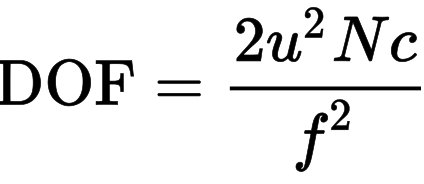The depth of field chart for the lens that I use only takes into account magnification and Fstop cause those are really the only two factors that matter when shooting macro.
This incorrect statement perfectly sums up your mistaken belief (and I suspect is the basis for the ‘real DoF’
@unfocused believes in).
I’ll give one more try, in the hopes that you,
@unfocused,
@Distinctly Average,
@takesome1 and anyone else who erroneously believes DoF is fixed at capture or that there’s a ‘real’ (perception-independent) definition of DoF actually reads the following with an open mind and an honest attempt to understand.
The mathematical formula used to calculate DoF for charts and calculators is:

In that equation,
u is subject distance,
N is the f/number,
f is the focal length, and
c is circle of confusion. The values for
u,
N and
f are set at the time of image capture. But those are
not the only variables.
Math being math, it is impossible to calculate DoF without a value for
c. The CoC variable is what defines ‘acceptable sharpness’ and it incorporates the parameters of output size, viewing distance and visual acuity. so obviously
c is going to vary based on factors that are all determined when the image is displayed and viewed, are not and cannot be set at the time of image capture.
Understandably, many photographers want a way to determine DoF ahead of time, but in reality that is impossible because it cannot be calculated for any image before the image is displayed and viewed (and because visual acuity matters, the actual DoF of any image can differ from one viewer to another).
Of course, those facts are completely unhelpful, and even if the true DoF cannot be known at the time of image capture, an approximation of DoF can be very helpful as a guideline for choosing the values —subject distance, f/number, and focal length— that can be determined before pressing the shutter button. Since the value of c cannot be determined before the image is captured, an approach commonly used in science is applied – making a set of defined assumptions that allow an unknown variable to be treated as a constant.
The industry-standard assumptions are an output size of an 8x10” print, a fixed viewing distance of 12”, and a visual acuity equivalent to 20/60 on a Snellen chart. Those assumptions allow assignment of a value for
c, which enables calculation of a value for DoF. The specific value calculated for a given subject distance, f/number, and focal length is only the absolutely correct value for those specific viewing conditions. But since DoF is directly proportional to
c, those assumptions are useful because they allow the comparison of
relative changes in DoF resulting from the photographer’s choices of subject distance, f/number, and focal length, i.e. the things that a photographer can control directly at the time of image capture.
Those set assumptions for output size, viewing distance and visual acuity are the basis for the DoF values in charts, calculators, and are also what lens manufacturers use in the tables they include in the lens documentation and for the DoF markings on lenses with a manual aperture control ring. If it’s a chart you downloaded somewhere it probably doesn’t have those assumptions printed on the chart, but if you read the supporting information for any good online DoF calculator, they are stated. (Well, the print size and viewing distance are stated, usually along with a reference to visual acuity which is almost never quantified but can be back-calculated from the CoC values used and some knowledge about the basis of the modern version of Snellen’s eye chart.)
Because the output size is arbitrarily set to an 8x10” print, DoF calculators incorporate the input (sensor) size and thus the magnitude of enlargement into the assumptions for
c. That’s why DoF calculators have you select your sensor size (and back in the day there were different printed charts for 35mm, medium and large format film). It's also why cropping an image in post but viewing the output at the same size as the uncropped image (e.g. filling the screen of your display) will change the DoF of the image.
To sum up, 'real depth of field' can only be determined if the output size, viewing distance and viewer's visual acuity are known. A DoF chart/calculator provides a useful approximation of DoF values based on a set of assumptions regarding output size, viewing distance, and visual acuity.
Because I don't expect you to simply take my word for it, I'll provide some quotes from identified sources that confirm what I posted above.
"
It's important to note that DOF isn't a lens characteristic like focal length or aperture. It takes into account some subjective factors like print size and viewing distance." "
DOF is at best a "fuzzy" concept, depending on subjective judgement of what appears to be sharp."
(Worth noting that as Bob points out, commonly used DoF calculators ignore the effects of diffraction on DoF, but it should be obvious given that the definition of DoF includes a term such as 'acceptable sharpness' and anyone who's tried to get more DoF by shooting macro at f/32 knows that diffraction affects sharpness.)
"
In order to calculate the depth of field, one needs to first decide on what will be considered acceptably sharp. More specifically, this is called the maximum circle of confusion (CoC), and is based on the camera sensor size (camera type), viewing distance and print size."

www.cambridgeincolour.com
(The CIC calculator has a 'show advanced' feature that allows one to select the output size, viewing distance, and visual acuity, such that if you know ahead of time you want to make a large print you can adjust the calculated DoF values to reflect that pre-capture decision.)
"
Most depth of field calculators you find online give DoF values based on an accepted Circle of Confusion (CoC). This CoC results from the combination of the selected camera sensor and the following viewing hypothesis: Print size of 8''×10'' (20cm×25cm); Viewing distance of 10" (25cm); Manufacturers standard visual acuity (the viewer can perceive details which size is roughly 0.01”). Remember that the Circle of Confusion establishes the frontier between what is considered to be in focus and out of focus in an image. The Circle of Confusion Calculatorwill help you learn more about it. Well, these assumptions work pretty well in most cases. But when you want to change the viewing conditions, you need to adjust the Circle of Confusion accordingly to get the adjusted depth of field values."
Get the total control over depth of field. This calculator allows you to use an adjusted Circle of Confusion to calculate the adjusted depth of field values according to your desired print size, viewing distance, camera sensor size and viewer’s visual acuity.

www.photopills.com
After reading the post above and the similar statements in just three of the many reputable sources on the subject, if you still believe that DoF values are determined only by factors set at the time of image capture I'd advise you to avoid any long ocean voyages because you may fall off the edge of the world.

www.nba.com




